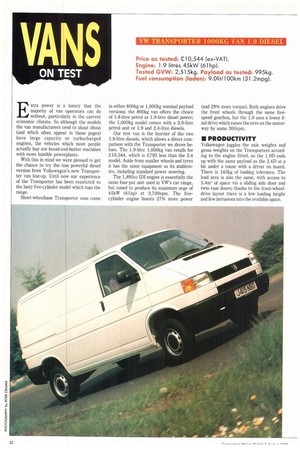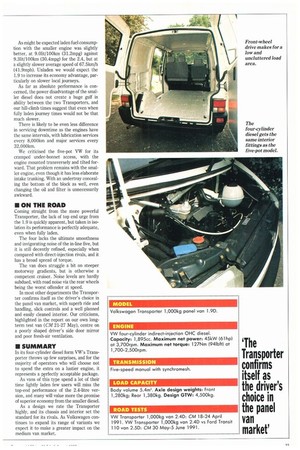VANS
Page 34

Page 35

If you've noticed an error in this article please click here to report it so we can fix it.
ON TEST
Extra power is a luxury that the majority of van operators can do without, particularly in the current economic climate. So although the models the van manufacturers tend to shout about (and which often appear in these pages) have large capacity or turbocharged engines, the vehicles which most people actually buy are bread-and-butter machines with more humble powerplants.
With this in mind we were pleased to get the chance to try the less powerful diesel version from Volkswagen's new Transporter van line-up. Until now our experience of the Transporter has been restricted to the lusty five-cylinder model which tops the range.
Short-wheelbase Transporter vans come in either 800kg or 1,000kg nominal payload versions; the 800kg van offers the choice of 1.8-litre petrol or 1.9-litre diesel power; the 1,000kg model comes with a 2.0-litre petrol unit or 1.9 and 2.4-litre diesels.
Our test van is the heavier of the two 1.9-litre diesels, which allows a direct comparison with the Transporter we drove before. The 1,9-litre 1,000kg van retails for £10,544, which is £793 less than the 2.4 model. Aside from smaller wheels and tyres it has the same equipment as its stablemate, including standard power steering.
The 1,895cc IDI engine is essentially the same four-pot unit used in VW's car range, but tuned to produce its maximum urge of 45kW (61hp) at 3,700rpm. The fivecylinder engine boasts 27% more power (and 29% more torque). Both engines drive the front wheels through the same fivespeed gearbox, but the 1.9 uses a lower final drive which raises the revs on the motorway by some 300rpm.
• PRODUCTIVITY Volkswagen juggles the axle weights and gross weights on the Transporters according to the engine fitted, so the 1.9D ends up with the same payload as the 2.4D at a bit under a tonne with a driver on board. There is 145kg of loading tolerance. The load area is also the same, with access to 5.4m' of space via a sliding side door and twin rear doors; thanks to the front-wheeldrive layout there is a low loading height and few intrusions into the available space. As might be expected laden fuel consumption with the smaller engine was slightly better, at 9.0lit/100km (31.2mpg) against 9.31it/100km (30.4mpg) for the 2.4, but at a slightly slower average speed of 67.5km/h (41.9mph). Unladen we would expect the 1.9 to increase its economy advantage, particularly on slower local journeys.
As far as absolute performance is concerned, the power disadvantage of the smaller diesel does not create a huge gulf in ability between the two Transporters, and our hill-climb times suggest that even when fully laden journey times would not be that much slower.
There is likely to be even less difference in servicing downtime as the engines have the same intervals, with lubrication services every 8,000km and major services every 32,000km.
We criticised the five-pot VW for its cramped under-bonnet access, with the engine mounted transversely and tilted for ward. That problem remains with the smaller engine, even though it has less elaborate intake trunking. With an undertray concealing the bottom of the block as well, even changing the oil and filter is unnecessarily awkward.
• ON THE ROAD
Coming straight from the more powerful Transporter, the lack of top end urge from the 1.9 is quickly apparent, but taken in isolation its performance is perfectly adequate, even when fully laden.
The four lacks the ultimate smoothness and invigorating noise of the in-line five, but it is still decently refined, especially when compared with direct-injection rivals, and it has a broad spread of torque.
The van does struggle a bit on steeper motorway gradients, but is otherwise a competent cruiser. Noise levels are hardly subdued, with road noise via the rear wheels being the worst offender at speed.
In most other departments the Transporter confirms itself as the driver's choice in the panel van market, with superb ride and handling, slick controls and a well planned and easily cleaned interior. Our criticisms, highlighted in the report on our own longterm test van (CM 21-27 May), centre on a poorly shaped driver's side door mirror and poor fresh-air ventilation.
• SUMMARY
In its four-cylinder diesel form VW's Transporter throws up few surprises, and for the majority of operators who will choose not to spend the extra on a lustier engine, it represents a perfectly acceptable package.
As vans of this type spend a lot of their time lightly laden few users will miss the top-end performance of the 2.4-litre version, and many will value more the .promise of superior economy from the smaller diesel.
As a design we rate the Transporter highly, and its chassis and interior set the standard for its rivals. As Volkswagen continues to expand its range of variants we expect it to make a greater impact on the medium van market.












































































